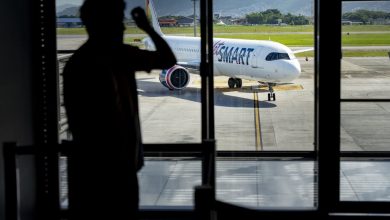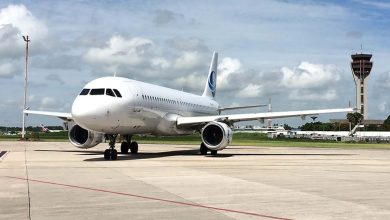Boeing admite baixo volume de pedidos de aeronaves widebody

Citing “softness” in the widebody-jet market, Boeing Chief Financial Officer Greg Smith said Wednesday that the airplane manufacturer will decide in the next couple months whether to further cut back planned production of its large 777 jet.
Smith indicated that the dearth of widebody-jet sales may also mean Boeing won’t raise output of the 787 Dreamliner as high as planned.
Coming on the heels of last month’s signal that Boeing could shutter the 747 jumbo-jet assembly line, the latest wavering on production means Boeing’s Everett plant could lose substantial work that would trigger significant job cuts.
Boeing has already shed more than 3,500 jobs in Washington state so far this year, with more to come due to previously announced cost-cutting efforts.
John Monroe, a former 777 executive at Boeing and now chief operations officer at the Economic Alliance of Snohomish County (EASC), said the Everett community would feel the impact of a Boeing downcycle at a plant that currently employs about 37,000 people.
He said a dip in Boeing work would also hit many suppliers to the jet maker around Everett.
“Our experience has been that significant production-rate cuts have been followed by reductions in the workforce,” Monroe said. “Job cuts seem inevitable.”
Boeing has already committed to slowing production of the current 777 from today’s rate of 8.3 jets per month — that’s 100 per year — down to 7 jets per month in 2017. The rate will decrease further to 5.5 jets per month during the transition to the new model 777X in 2018.
Speaking at the Jefferies Industrials Conference in New York, Smith said it’s unclear if new orders will arrive in time to match those planned production rates.
“Over the next couple of months, we’ll know,” Smith said. “We’ll either solidify those orders … or we’ll modify the production rate.”
Boeing has said it needs to sell 40 to 60 jets per year to fill all the open 777 delivery slots between now and the end of the decade.
So far this year, it has booked just eight net new orders.
Smith did not indicate how much lower the rate might go.
Local aviation analyst Scott Hamilton of Leeham.net said the 777 order backlog suggests a rate of about 4 aircraft per month is sustainable without further sales.
One indicator that the 777 market is in trouble came in a regulatory filing late last month by global aircraft lessor Intrepid Aviation.
Intrepid, which has six 777s on order from Boeing, revealed it hasn’t yet found airlines to take four of those planes — three scheduled for delivery in fall next year and the fourth in early 2018.
Sam Pearlstein, aerospace analyst with Wells Fargo, wrote in a note to investors that, “This highlights why Boeing’s goal of 40-plus annual new 777 orders will remain a challenge.”
nesday, Smith also lowered expectations on production of the 787 Dreamliner.
Boeing is now producing 12 of the jets per month and planned to raise that to 14 per month by the end of the decade.
Now that rate hike looks uncertain.
“We’re going to match supply and demand, and if it doesn’t play out to be 14, then we’ll adjust accordingly,” Smith said. “It’s not the end of the world if you went from 14 to 12 … We can still be profitable.”
While the 787 sold at record levels before entering service, sales slowed dramatically afterward.
In the first five years of sales, Boeing sold 700 Dreamliners. In the five and a half years since, it has sold 400 more.
So far this year, Boeing has added just 19 net new orders for the jet.
Last week, Leeham.net’s Hamilton wrote that even the planned rate of 12 Dreamliners per month could be challenging to sustain without an uptick in 787 sales.
In an interview Wednesday, Hamilton said that if 787 production is further pared back, it’s likely the cutbacks will come in Everett rather than at the assembly line in North Charleston, S.C.
The South Carolina line’s prospects are bolstered by the fact that Boeing will build the largest Dreamliner model, the 787-10, only at that plant.
If the 787 rate were cut, along with the possibility of a 777 production cut and the 747 line closing, “By the end of the decade, it’s very possible we could be looking at some lean times in Everett,” Hamilton said.
And he warned that the new 777 model in development, the 777X, doesn’t have enough sales to suggest a big recovery when it enters service in 2020.
Boeing, which has 306 firm orders for that new jet, has booked no new orders within the past year. Hamilton said that’s only enough to sustain a production rate of four or five a month.
“The 777X isn’t going to be any kind of savior,” he said.
Hamilton said Washington state officials need to do “a deep dive into the potential scenarios” and come up with a proactive plan to capture new work for Everett — whether that’s Boeing’s next new airplane or aerospace work from other companies.
Monroe said his economic- development group is talking to various European companies, both aerospace and non-aerospace, about locating new facilities in Snohomish County and will continue to push an economic-diversification strategy.
He said the state should also step up the funding of worker-retraining programs.
Over the past couple of years, as Boeing has shed jobs in Washington state, its local unions have ratcheted up the pressure on state legislators to make the company accountable for maintaining jobs here, by linking the state’s aerospace tax incentives to employment levels.
Yet as further job losses now loom, Monroe argued for the opposite approach to keep as much Boeing work here as possible.
He said state legislators “need to avoid any reductions in the tax incentives programs that could adversely affect Boeing.”
Jon Holden, president of the International Association of Machinists (IAM) district 751, said the union has “great concern” over any job losses.
He said that in the event of a real industry downturn, the IAM is prepared to discuss how to handle tax incentives — implying that Boeing needn’t be penalized if job cuts are the result of an industry downcycle beyond its control.
But since the previous peak employment in fall 2012, Boeing has shed 11,000 jobs in Washington state, and Holden said this was a period of record production, when Boeing chose to move thousands of jobs to other states.
“If there is no accountability (by Boeing), we’ll continue to see infrastructure, capability and capacity created elsewhere,” Holden said. “Even in a downturn, we should protect the infrastructure here so that when there’s an upswing, that upswing will happen in our state.”
Smith meanwhile told his Wall Street audience Wednesday that even if the potential cuts he discussed do happen, the company’s cash flow will stay healthy — thanks largely to planned increases in production of the single-aisle 737 jet built in Renton.
“You are still going to see growing cash flows going forward,” Smith assured investors. “That is ultimately what matters.”
Fonte: AviationPros 11/08/2016





